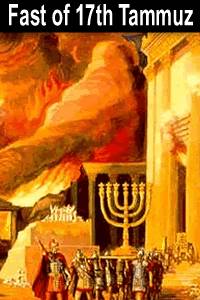The Fast of the 17th of Tammuz

The Fast of the 17th of Tammuz marks the start of three weeks of mourning, commemorating calamities like the breaking of the Tablets and the breach of Jerusalem’s walls. This period, known as “Bein HaMetzarim”, is a time for fasting, spiritual purification, and remembering the profound losses. We remind ourselves of losing God’s Grace and commit to connecting forever with the Divine.
Three Weeks of Mourning
In the Jewish calendar, the period from the 17th of Tammuz to the 9th of Av, a span of three weeks, is observed as a time of mourning. Similar to other ominous and unfavorable days (such as Tisha B’Av and Asarah B’Tevet), Jews fast and refrain from any form of celebration. They fast (ta’anit) and perform religious ceremonies in synagogues to commemorate the tragic events and calamities of their past.
Disastrous Events on 17th Tammuz
The disastrous events recorded in Jewish history include:
- The breaking of the Tablets of the Ten Commandments.
- The cessation of the daily offering in the First Temple.
- The breach of the walls of Jerusalem and the enemy’s infiltration during the Second Temple period. Jewish scholars also believe that the fall of Jerusalem’s walls during the First Temple period happened on the 9th of this month.
- The burning of the Torah scrolls by Apostomos.
- The placement of an idol of Jupiter in the Holy Temple by Apostomos.
The breaking of the tablets
Chapter four of Tractate Ta’anit of the Mishnah describes the 17th of Av as one of the most disastrous days in Jewish history. This was the day that Moses descended from Mount Sinai after being there for forty days, only to discover that some members of the tribe had turned to calf-worshiping in his absence. Angered by this lack of faith, he shattered the tablets.
For this turn of faith, God intended to destroy the Israelites, but Moses interceded on their behalf (Exodus 32:11-14). The 17th of Tammuz became known as a day of spiritual defeat and the loss of Divine Grace. It became a day of fasting and spiritual purification. Jews observe two fasts between the 17th of Tammuz and the 9th of Av, reflecting on the significant events that occurred during these three weeks. This period is known as “Bein HaMetzarim” (The Days of Distress).
Destruction of the Holy Temple and exile
Another major calamity during this time was the destruction of the Holy Temple, which led to the diaspora and scattering of the Israelites across the world, known as the Galut (exile). Although this catastrophe happened on the ninth day of the fourth month (Tammuz), the fall of Jerusalem on the 17th of Tammuz the following year led to the establishment of the fast day.
The Book of Jeremiah, chapter 56, verses 6-7, mentions that on the ninth day of Tammuz, during the reign of Zedekiah, the famine in Jerusalem became so severe after three years of siege by Nebuchadnezzar that there was no bread left for the people. The city walls were breached by the enemies, and Jerusalem’s resistance finally collapsed. Nebuchadnezzar’s army entered the city, destroying its defenses, killing innocent people, and setting houses on fire. However, the temple priests resisted and managed to protect the Holy Temple until the seventh day of Av. They continued the daily offerings and rituals, but due to the prolonged siege, they couldn’t procure sheep for sacrifices, leading to the cessation of offerings. A similar event occurred 490 years later during the destruction of the Second Temple in the same month.
From the Book of Psalms by David (Psalms:137), “[After the Israelites were taken into captivity,] by the rivers of Babylon, we sat and wept when we remembered Zion. We hung our harps on the willows there, for our captors asked us for songs, and our tormentors demanded songs of joy. They said, ‘Sing us one of the songs of Zion!’ How can we sing the songs of the Lord in a foreign land? May I lose my right hand, O Jerusalem, If I forget you ever.”
The Four Fasts in Jewish Tradition
After the destruction of the First and Second Temples and the exile of the Jews from Jerusalem, four fasts were established to commemorate the tragedies:
- Tzom Gedalya (The Fast of Gedaliah; צוֹם גְּדַלְיָה),
- Asarah BeTevet (the Fast of Tevet 10th ; עשרה בטבת),
- Shivah Asar b’Tammuz (The Fast of 17th of Tammuz; שבעה עשר בתמוז),
- and Tisha B’Av (The Fast of 9th of Av; תִּשְׁעָה בְּאָב).
The true purpose of fasting
Although fasting in Jewish culture is seen as a form of suffering, its primary purpose is to remember the calamities or specific issues, fostering spiritual growth. In the Book of Isaiah, Chapter 58, Verses 3-7, God reminds the Israelites that the true purpose of fasting is not merely to endure physical hardship or pretend piety, but to eliminate injustice, show empathy, and help the oppressed. This aligns with the Torah’s commandment: “Love your neighbor as yourself”.
Astrological Significance and Beliefs
In the Hebrew calendar, the fourth month is Tammuz. The name Tammuz, like some other Hebrew months, is of Babylonian origin. Its zodiac sign is Cancer, symbolizing movement, changing behaviors, and worry. This sign also represents home, family, and security (Rosh Chodesh). According to the Book of Zohar, the month of Tammuz is often marked by unfortunate events, a period filled with stress, anxiety, and fear.
Kabbalists believe that the month of Tammuz is filled with turbulence and instability, with a heavy, chaotic atmosphere. They assert that negative energy prevails more in this month than in any other. They say, “Blessed is the one who can survive these days safely!” Perhaps this is because of the disasters and misfortunes that have befallen the Israelites throughout history during this month.

Sources:
Mythological Beliefs: Yosef Setareshenas


 فارسی
فارسی